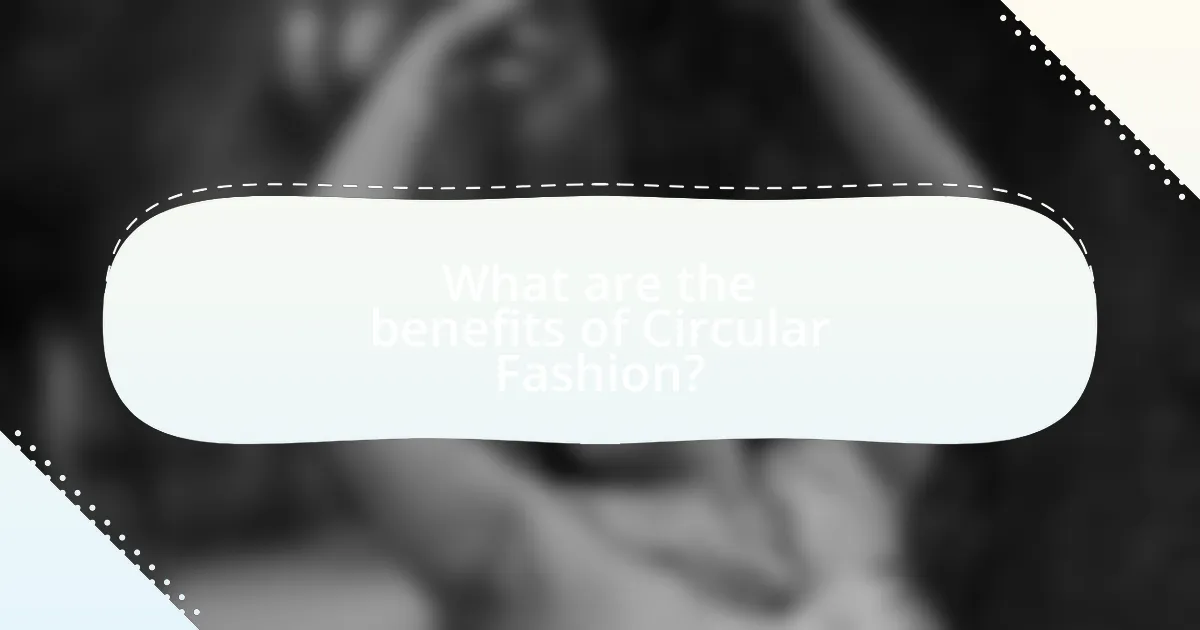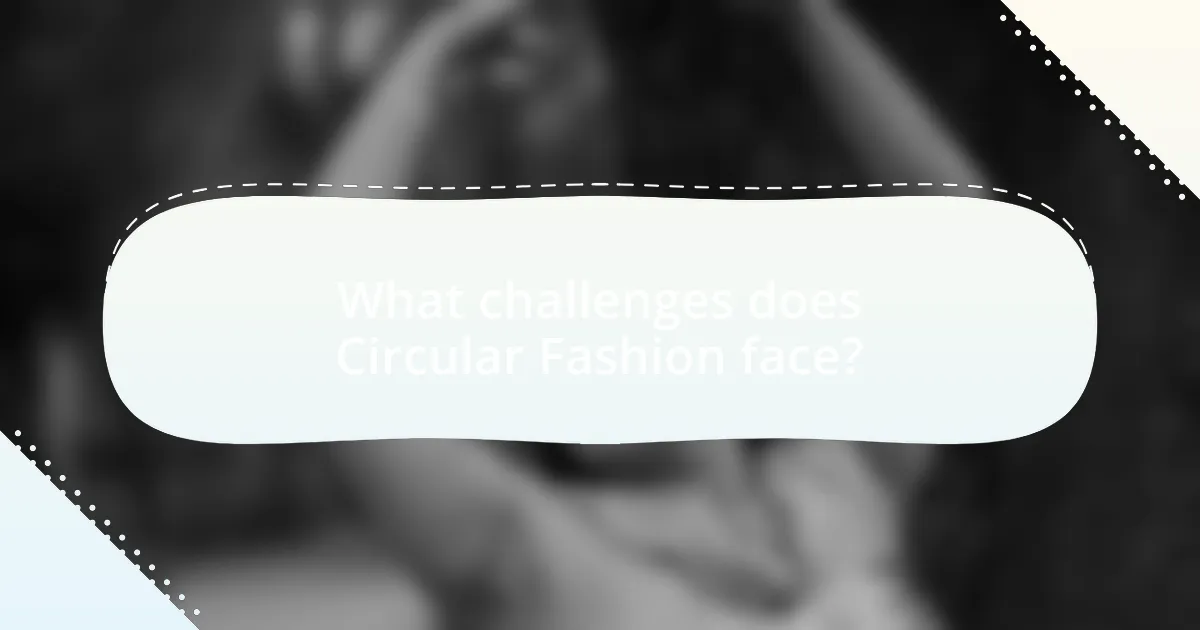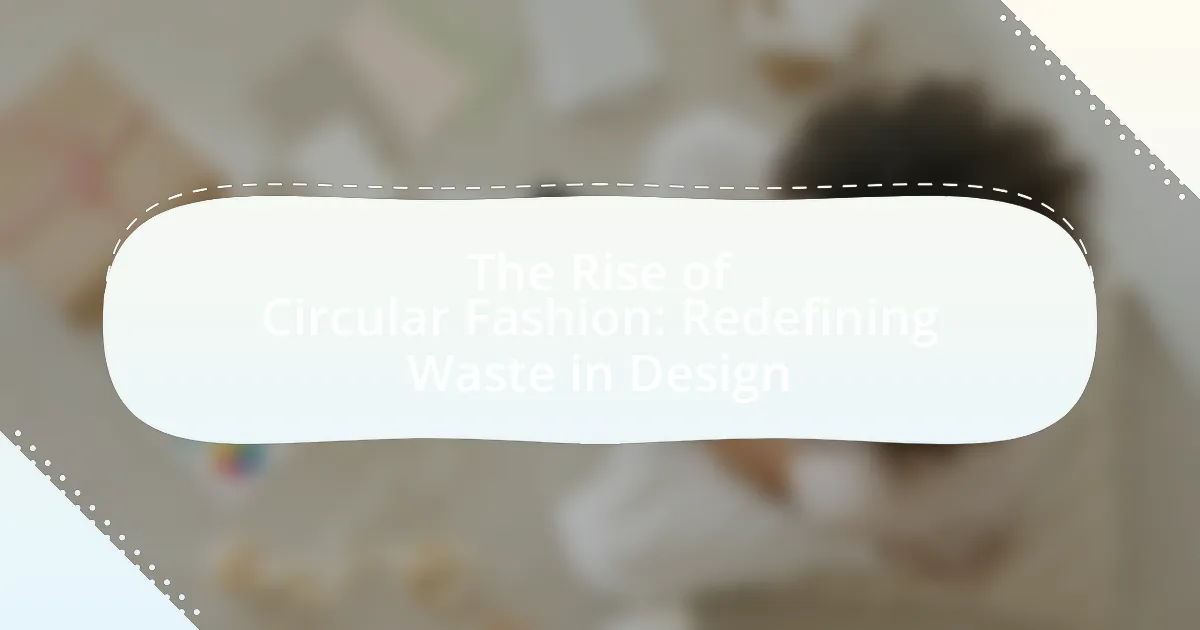Circular fashion is a sustainable approach to clothing design and production that focuses on minimizing waste and environmental impact through practices such as recycling, upcycling, and the use of biodegradable materials. This model contrasts with traditional fashion’s linear “take, make, dispose” approach by promoting a closed-loop system where products are designed for longevity and recyclability. Key principles of circular fashion include resource efficiency, designing for durability, and ensuring recyclability, all aimed at reducing the fashion industry’s significant waste and carbon emissions. The article also explores the economic benefits of circular fashion, the challenges it faces, and the role of consumer behavior in driving sustainable practices within the industry.

What is Circular Fashion?
Circular fashion is a sustainable approach to clothing design and production that emphasizes the continual use of resources, minimizing waste and environmental impact. This model promotes practices such as recycling, upcycling, and the use of biodegradable materials, aiming to create a closed-loop system where products are designed for longevity and can be easily disassembled and repurposed. According to the Ellen MacArthur Foundation, transitioning to circular fashion could reduce global greenhouse gas emissions by 44% by 2030, highlighting its potential to significantly mitigate climate change while fostering a more sustainable economy.
How does Circular Fashion differ from traditional fashion?
Circular fashion differs from traditional fashion primarily in its approach to sustainability and resource management. While traditional fashion often follows a linear model of “take, make, dispose,” circular fashion emphasizes the continuous use of materials through recycling, upcycling, and designing for longevity. This model aims to minimize waste and reduce environmental impact by keeping products and materials in use for as long as possible. According to the Ellen MacArthur Foundation, transitioning to a circular economy could reduce global greenhouse gas emissions by 39% by 2030, highlighting the significant environmental benefits of circular fashion compared to traditional practices.
What are the key principles of Circular Fashion?
The key principles of Circular Fashion include designing for longevity, promoting resource efficiency, and ensuring recyclability. Designing for longevity involves creating garments that are durable and timeless, reducing the need for frequent replacements. Promoting resource efficiency focuses on minimizing waste and utilizing sustainable materials throughout the production process. Ensuring recyclability means that products are designed to be easily disassembled and repurposed at the end of their life cycle, thereby reducing landfill waste. These principles collectively aim to create a sustainable fashion ecosystem that minimizes environmental impact and promotes responsible consumption.
Why is sustainability important in Circular Fashion?
Sustainability is crucial in Circular Fashion because it minimizes environmental impact by promoting resource efficiency and waste reduction. Circular Fashion aims to create a closed-loop system where materials are reused, recycled, or repurposed, significantly lowering the demand for new resources. According to the Ellen MacArthur Foundation, the fashion industry is responsible for 10% of global carbon emissions, highlighting the urgent need for sustainable practices to mitigate climate change. By adopting sustainable methods, Circular Fashion not only conserves natural resources but also fosters economic resilience and social equity within communities.
What are the main goals of Circular Fashion?
The main goals of Circular Fashion are to minimize waste, extend the lifecycle of products, and promote sustainable resource use. By designing products for longevity and recyclability, Circular Fashion aims to reduce the environmental impact of the fashion industry, which is responsible for significant waste and pollution. According to the Ellen MacArthur Foundation, the fashion industry generates over 92 million tons of waste annually, highlighting the urgent need for a circular approach that reuses materials and reduces reliance on virgin resources.
How does Circular Fashion aim to reduce waste?
Circular Fashion aims to reduce waste by promoting the reuse, recycling, and upcycling of materials within the fashion industry. This approach minimizes the reliance on virgin resources and extends the lifecycle of products, thereby decreasing the volume of textile waste that ends up in landfills. According to the Ellen MacArthur Foundation, the fashion industry is responsible for 92 million tons of waste annually, highlighting the urgent need for sustainable practices. By implementing circular principles, brands can significantly lower their environmental impact and contribute to a more sustainable economy.
What role does consumer behavior play in Circular Fashion?
Consumer behavior is crucial in Circular Fashion as it directly influences the demand for sustainable products and practices. When consumers prioritize eco-friendly choices, they drive brands to adopt circular principles, such as recycling, upcycling, and sustainable sourcing. Research indicates that 66% of global consumers are willing to pay more for sustainable brands, highlighting the significant impact of consumer preferences on market trends. This shift in behavior not only encourages companies to innovate in their design processes but also fosters a culture of sustainability, ultimately reducing waste and promoting a circular economy.

What are the benefits of Circular Fashion?
Circular fashion significantly reduces waste and promotes sustainability in the fashion industry. By designing products for longevity, reuse, and recycling, circular fashion minimizes the environmental impact associated with textile production and disposal. According to the Ellen MacArthur Foundation, transitioning to a circular economy in fashion could reduce greenhouse gas emissions by 44% by 2030. Additionally, circular fashion fosters economic opportunities through the creation of new business models, such as rental and resale platforms, which can generate revenue while extending the lifecycle of garments.
How does Circular Fashion impact the environment?
Circular fashion significantly reduces environmental impact by minimizing waste and resource consumption. This approach promotes the reuse, recycling, and upcycling of materials, which leads to a decrease in landfill waste and a reduction in the demand for new raw materials. For instance, the Ellen MacArthur Foundation reports that the fashion industry is responsible for 92 million tons of waste annually, and adopting circular practices can help mitigate this issue by extending the lifecycle of garments. Additionally, circular fashion can lower carbon emissions; a study by McKinsey & Company indicates that transitioning to a circular economy in fashion could reduce greenhouse gas emissions by 44% by 2030. Thus, circular fashion not only addresses waste management but also contributes to significant environmental sustainability.
What are the ecological advantages of adopting Circular Fashion?
Adopting Circular Fashion significantly reduces environmental impact by minimizing waste and resource consumption. This approach promotes the reuse and recycling of materials, which can lead to a decrease in landfill waste; for instance, the Ellen MacArthur Foundation reports that the fashion industry is responsible for 92 million tons of waste annually, much of which could be mitigated through circular practices. Additionally, Circular Fashion conserves natural resources by extending the lifecycle of products, thereby reducing the need for new raw materials. Research indicates that if the fashion industry shifted to circular models, it could reduce greenhouse gas emissions by 44% by 2030, highlighting the substantial ecological benefits of this approach.
How does Circular Fashion contribute to resource conservation?
Circular Fashion significantly contributes to resource conservation by promoting the reuse, recycling, and upcycling of materials, which reduces the demand for new resources. This approach minimizes waste generation and lowers the environmental impact associated with the extraction and processing of raw materials. For instance, a study by the Ellen MacArthur Foundation highlights that transitioning to a circular economy in the fashion industry could reduce greenhouse gas emissions by 44% by 2030, demonstrating the potential for substantial resource conservation.
What economic benefits does Circular Fashion provide?
Circular Fashion provides significant economic benefits by reducing waste and promoting resource efficiency. This model encourages the reuse and recycling of materials, which can lower production costs and create new revenue streams. For instance, the Ellen MacArthur Foundation reports that transitioning to a circular economy in the fashion industry could generate $560 billion in economic benefits by 2030 through reduced material costs and increased product lifespan. Additionally, Circular Fashion fosters innovation in sustainable materials and processes, leading to job creation in green sectors.
How can Circular Fashion create new business opportunities?
Circular Fashion can create new business opportunities by promoting sustainable practices that reduce waste and enhance resource efficiency. This approach encourages companies to innovate in product design, enabling them to offer services such as repair, resale, and recycling, which can lead to new revenue streams. For instance, the global market for second-hand clothing is projected to reach $64 billion by 2024, indicating a significant demand for circular business models. Additionally, brands that adopt circular practices can improve their brand loyalty and attract environmentally conscious consumers, further expanding their market reach.
What are the potential cost savings for companies adopting Circular Fashion?
Companies adopting Circular Fashion can achieve significant cost savings through reduced material costs, lower waste disposal fees, and increased resource efficiency. By reusing materials and designing for longevity, companies can minimize the need for new raw materials, which can account for up to 60-70% of production costs in the fashion industry. Additionally, implementing circular practices can lead to a decrease in waste management expenses, as less waste is generated. A study by the Ellen MacArthur Foundation found that transitioning to a circular economy in fashion could unlock $560 billion in economic benefits by 2030, highlighting the financial advantages of adopting these sustainable practices.

What challenges does Circular Fashion face?
Circular Fashion faces several challenges, including consumer awareness, supply chain complexity, and economic viability. Consumer awareness is limited, as many individuals are not fully informed about the benefits and practices of Circular Fashion, which hinders adoption. Supply chain complexity arises from the need for collaboration among various stakeholders, including manufacturers, retailers, and recyclers, to create a closed-loop system. Economic viability is also a significant challenge, as the initial costs of implementing sustainable practices can be high, and the market for recycled materials is often unstable. These challenges collectively impede the widespread implementation of Circular Fashion principles.
What are the barriers to implementing Circular Fashion practices?
The barriers to implementing Circular Fashion practices include high production costs, lack of consumer awareness, and insufficient infrastructure for recycling and upcycling. High production costs arise from the need for sustainable materials and processes, which can be more expensive than traditional methods. Lack of consumer awareness limits demand for circular products, as many consumers are not informed about the benefits of sustainable fashion. Additionally, insufficient infrastructure for recycling and upcycling hinders the ability to effectively process and repurpose materials, making it challenging for brands to adopt circular practices. These barriers collectively impede the transition to a more sustainable fashion industry.
How do supply chain issues affect Circular Fashion?
Supply chain issues significantly hinder the effectiveness of Circular Fashion by disrupting the flow of materials necessary for sustainable production. When supply chains face delays or shortages, it becomes challenging for brands to source recycled or eco-friendly materials, which are essential for creating circular products. For instance, a report from the Ellen MacArthur Foundation highlights that disruptions in material availability can lead to increased reliance on virgin resources, undermining the principles of Circular Fashion. Additionally, inefficiencies in logistics can result in higher costs and longer lead times, further discouraging brands from adopting circular practices.
What role does consumer awareness play in the challenges of Circular Fashion?
Consumer awareness significantly impacts the challenges of Circular Fashion by influencing purchasing decisions and promoting sustainable practices. When consumers are informed about the environmental and social implications of their fashion choices, they are more likely to support brands that prioritize circularity, such as those that use recycled materials or offer take-back programs. According to a 2021 survey by McKinsey, 66% of consumers expressed a willingness to pay more for sustainable fashion, highlighting the importance of awareness in driving demand for circular practices. However, a lack of understanding about what Circular Fashion entails can lead to skepticism and resistance, making it essential for brands to educate consumers effectively.
How can these challenges be overcome?
To overcome the challenges of circular fashion, stakeholders must implement sustainable practices, enhance collaboration, and invest in innovative technologies. Sustainable practices include using eco-friendly materials and adopting waste-reduction strategies, which can significantly lower environmental impact. Collaboration among brands, consumers, and policymakers fosters a shared commitment to circularity, as seen in initiatives like the Ellen MacArthur Foundation’s Circular Fibres Initiative, which aims to create a circular economy for textiles. Additionally, investing in technologies such as recycling innovations and digital platforms for second-hand markets can streamline processes and improve resource efficiency, as evidenced by the growth of companies like Rent the Runway, which promotes clothing rental as a sustainable alternative.
What strategies can brands adopt to promote Circular Fashion?
Brands can adopt several strategies to promote Circular Fashion, including implementing take-back programs, utilizing sustainable materials, and fostering consumer education. Take-back programs encourage customers to return used products for recycling or refurbishment, thereby reducing waste and extending product life cycles. Utilizing sustainable materials, such as organic cotton or recycled polyester, minimizes environmental impact and supports resource conservation. Additionally, fostering consumer education through campaigns that highlight the benefits of Circular Fashion can increase awareness and drive demand for sustainable practices. These strategies collectively contribute to a more sustainable fashion industry by promoting responsible consumption and reducing waste.
How can collaboration within the industry enhance Circular Fashion initiatives?
Collaboration within the fashion industry can significantly enhance Circular Fashion initiatives by fostering shared resources, knowledge, and innovation. When brands, manufacturers, and retailers work together, they can develop standardized practices for recycling and upcycling materials, which streamlines processes and reduces waste. For instance, the Ellen MacArthur Foundation’s “A New Textiles Economy” report highlights that collaboration can lead to the creation of a circular economy framework that encourages sustainable practices across the supply chain. This collective effort not only amplifies the impact of individual initiatives but also accelerates the transition towards sustainable fashion by pooling expertise and resources, ultimately driving systemic change in the industry.
What are practical steps for consumers to support Circular Fashion?
Consumers can support Circular Fashion by prioritizing sustainable purchasing decisions, such as buying second-hand clothing, choosing brands that emphasize circularity, and investing in high-quality, durable items. By purchasing second-hand clothing, consumers extend the lifecycle of garments, reducing waste and resource consumption. Brands that focus on circularity often use recycled materials and offer take-back programs, which encourage recycling and repurposing of clothing. Additionally, investing in high-quality items reduces the frequency of purchases, promoting a more sustainable consumption pattern. According to a report by the Ellen MacArthur Foundation, extending the life of clothing by just nine months can reduce carbon, water, and waste footprints by 20-30%.
How can consumers make more sustainable fashion choices?
Consumers can make more sustainable fashion choices by prioritizing brands that utilize eco-friendly materials and ethical production practices. Research indicates that the fashion industry is responsible for 10% of global carbon emissions, highlighting the importance of selecting brands that minimize their environmental impact. Additionally, consumers can opt for second-hand clothing, which reduces waste and extends the lifecycle of garments. According to a study by the Ellen MacArthur Foundation, extending the life of clothes by just nine months can reduce carbon, water, and waste footprints by 20-30%. By supporting sustainable brands and engaging in practices like thrifting, consumers contribute to a circular fashion economy that redefines waste in design.
What are the best practices for recycling and upcycling clothing?
The best practices for recycling and upcycling clothing include donating unwanted garments, using textile recycling programs, and creatively transforming old clothing into new items. Donating clothing to charities or thrift stores extends the life of garments and reduces landfill waste. Textile recycling programs, such as those offered by H&M and Patagonia, ensure that materials are repurposed rather than discarded. Upcycling involves creatively altering clothing, such as turning old jeans into bags or patching fabric scraps into quilts, which not only reduces waste but also promotes sustainable fashion practices. According to the Ellen MacArthur Foundation, the fashion industry could reduce its environmental impact significantly by adopting circular practices, emphasizing the importance of recycling and upcycling in achieving sustainability goals.

Leave a Reply